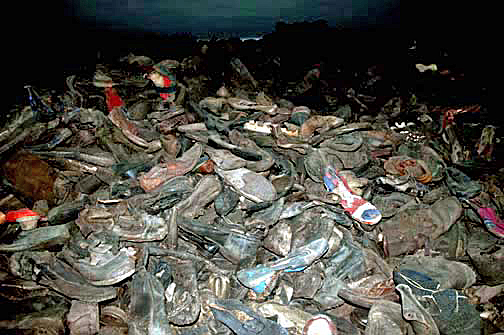
Display of shoes at the United States Holocaust Memorial Museum Photo credit Paul Hosefros/The New York Times
The photo above accompanied an article in the New York Times, which you can read in full here. The Times article is about a Jewish man who was finally able to buy a German car, at the age of 57, because the death of his parents had finally released him from a promise to “never buy German.”
So what does buying a German car have to do with the worn-out shoes found at Auschwitz and other concentration camps by the Allied liberators of the camps? I previously blogged about the worn-out shoes here. In the absence of any records which include the names of the 6 million Jews who were killed in the genocide of the Jews, known as The Holocaust, the shoes are used to represent the six million.
A typical tour of the main Auschwitz camp begins in Block 15, shown in the photo above, which houses an exhibit entitled Historical Introduction. Organized groups begin their tour of the museum buildings here and then move on to Blocks 4, 5, 6, and 7 which are in the last row of barracks buildings. Block 5 is similar to Block 15, shown in the photo above.
In Block 5, there are displays devoted to the “Material Evidence of Crime.” One of the displays shows hundreds of shoes in a huge glass case that takes up half of a barracks room. The shoes seem to be deteriorating and are mostly the same dark gray color, except for a few women’s or children’s shoes that are made of red leather. The red shoes stand out like the red coat worn by the little girl in Schindler’s List, a black and white picture.
The Theatergebäude (theater building) which is located just outside the Auschwitz main camp, was used as a clothing warehouse and it was stuffed full of clothing and shoes when the camp was liberated by Soviet troops on January 27, 1945.
Why didn’t the Nazis burn the shoes in the Theater building to destroy the evidence of the killing of the Jews? It must have just slipped their minds, or maybe it was because they didn’t want to destroy such a nice brick building.
All but six of the clothing warehouse buildings at Birkenau had been set on fire when the camp was abandoned by the Nazis on January 18, 1945 and, strangely, the buildings were still burning when the Soviet liberators arrived on January 27, 1945.
In any case, the Nazis left behind 43,000 pairs of shoes which were found in one of the six warehouses at Auschwitz-Birkenau, which were not set on fire. These shoes have been divided up among several Holocaust Museums, including the US Holocaust Memorial Museum in Washington, DC.
This quote is from the New York Times article about the man who was finally able to buy a German car after his parents died:
“I almost threw up in the room filled with piles of shoes….. […] My father died in 2003 and my mother in 2010. This year, at age 57, when I needed a new car, I could finally buy a German one.”
The shoes, from the warehouse at Auschwitz-Birkenau, are symbolic of Jewish hatred of Germans, which extends to the next generation and beyond.






















